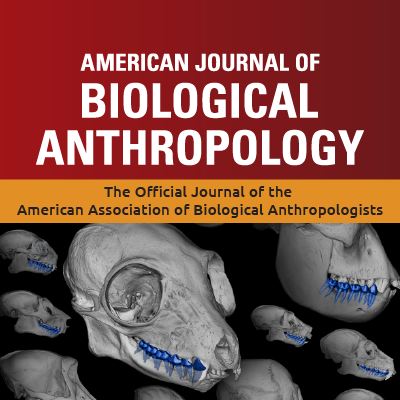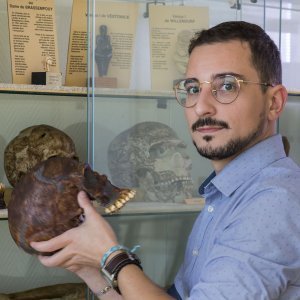
American Journal of Biological Anthropology
@AmJBioAnth
Followers
2K
Following
204
Media
78
Statuses
739
Journal of the American Association of Biological Anthropologists (AABA)
Joined August 2019
Locomotion is central to human survival, but in adolescents, preferred walking speeds aren't always the most energy-efficient. Greater walking flexibility reduces energetic penalties, and may offer adaptive advantages in human evolution. #AJBA
https://t.co/jfNZiZI79E
onlinelibrary.wiley.com
Objectives Locomotion is fundamental to the survival of our species. The most comfortable walking speed may be the most efficient for allocating conserved energy for other functions. However,...
0
6
14
Bio anth often treats populations as key units of evolution, but the term is used inconsistently. There is variation in how populations are defined (sample sizes, time ranges, characteristics), making comparisons hard. Clearer definitions are needed #AJBA
https://t.co/xyc0D6empc
onlinelibrary.wiley.com
Objectives With a focus on variability, biological anthropology has nominally centered the population as a key unit of analysis and node of evolutionary change. In this paper, we examine constructi...
0
0
0
This study integrates evolutionary theory into forensic practice to improve how sex is estimated from skeletal remains. By accounting for morphological integration, sex estimation can be accomplished with less variables without compromising accuracy #ajba
https://t.co/lWs9nq4FFr
onlinelibrary.wiley.com
This study shows measurements in the DSP2 sex-estimation method cluster into integrated modules. Selecting one measurement per module preserves accuracy while reducing redundancy, demonstrating the...
0
2
10
This study revealed how genetic diversity, diet, and lifestyle shaped dental stress markers in the indigenous populations of the Canary Islands. The results show island-level differences tied to subsistence strategies. Access the article below! #ajba
https://t.co/UbvWjKxPHU
onlinelibrary.wiley.com
Objectives This study evaluated the influence of genetic diversity, subsistence strategies, age at death, and their interplay on the prevalence of linear enamel hypoplasias (LEHs) in the indigenous...
0
0
0
At Roonka, Australia, osteoarthritis wasn’t the ‘inevitable’ part of aging we assume today. Rare before European contact, OA here reveals how local biocultural entanglements shape the body, challenging ideas of universal biology #ajba
https://t.co/fauDqnn7KS
onlinelibrary.wiley.com
Osteoarthritis among a Holocene Australian Aboriginal population was analyzed in collaboration with the River Murray and Mallee Aboriginal Corporation. The pattern of OA among people at Roonka does...
0
1
1
The terminal Pleistocene was key in shaping modern populations, marked by high variability & regional divergence. Yahuai-1 (YH1;~16kya, southern China) offers insight into human diversity & population dynamics in SE Asia during this pivotal time #AJBA
https://t.co/7mT4typkFw
onlinelibrary.wiley.com
Objective The terminal Pleistocene is a crucial stage in the formation and differentiation of modern populations. Recent studies show that the population during this period had significant morpholo...
0
0
0
Racial disparities in birth & breastfeeding persist among non-Hispanic Black women. This study found labor mismatch (birth intent vs outcome) didn’t affect breastfeeding but income, education & BMI can impact women meeting birth & breastfeeding goals #ajba
https://t.co/JXnFeyXkwc
onlinelibrary.wiley.com
Objectives Despite growing attention on the issue, racial disparities in birth and breastfeeding outcomes in the United States persist. However, few biocultural studies have explored the interactio...
0
0
2
Epidemiologic research suggests sedentism increases irritable bowel syndrome (IBS) risk. This study suggests IBS may be driven by longitudinal effects of exercise alongside other environmental and behavioral factors contributing to energetic balance #AJBA
https://t.co/eXDT6KRqhw
onlinelibrary.wiley.com
Objectives Rising rates of noncommunicable diseases have been attributed to evolutionary mismatch between past physical activity and sedentary, post-industrial behavior. Epidemiologic research...
0
0
1
'Toothnroll' is a new R package for landmarking, measuring and mapping dental tissues of hominoid anterior teeth. Additionally, the package applicability could extend beyond the fields of paleoanthropology and biological anthropology #AJBA
https://t.co/xTcxJymS88
onlinelibrary.wiley.com
Objectives We present Toothnroll, a new R package for landmarking, measuring and mapping dental tissues of hominoid anterior teeth. Methods The required inputs include 3D meshes of enamel, dentine...
0
1
4
This study explored how variations in body mass may have reflected changes London during the Black Death, and the relationship between epidemic diseases & changes in body size in the past, revealing new insights into health after extreme devastation #AJBA
https://t.co/jV8lfQF4mx
onlinelibrary.wiley.com
Objectives The higher mortality rate of the Black Death compared to later epidemics has prompted bioarchaeologists to address the health status of past plague victims and whether this may have...
0
2
6
Object manipulation by chacma baboons in Gorongosa National Park varies by age, sex, and habitat type. This study contributes to current discussions about the emergence of habitual tool use across the primate order #AJBA #baboons #tools
https://t.co/XdFJSqHt8H
onlinelibrary.wiley.com
Object manipulation by chacma baboons (Papio ursinus) in Gorongosa National Park varies by age, sex, and habitat type, with playful use more common in juveniles and food-focused use in adults,...
0
3
16
As ethics evolve globally, there is growing pressure on paleoanthropology to revisit its ethical practices, help create globally informed standards, and better align fossil handling with practices in related fields, such as human tissue research #AJBA
https://t.co/iXh8PWxjrR
onlinelibrary.wiley.com
Ethical considerations around research and education with modern human subjects, use of human tissue, and studies involving humans are ubiquitous within the global scientific community. This commen...
0
3
10
This study investigates enamel thickness among Atapuerca hominins. The results caution against using enamel thickness alone for taxonomic classification and emphasize the importance of analyzing both upper and lower dentitions across dental classes #AJBA
https://t.co/Rk9NHj6ZzA
onlinelibrary.wiley.com
Objectives This study investigates premolar tissue proportions in the Atapuerca hominins to assess whether Homo antecessor (TD6) and Sima de los Huesos (SH) specimens exhibit thick or thin enamel,...
0
7
13
Disparities in higher education are connected to legacies of structural harm and stratification. Understanding how these legacies impact forensic practice matters for the creation of inclusive spaces and the reduction of barriers within the field #AJBA
https://t.co/26nQk1qvUo
onlinelibrary.wiley.com
The experience of disparity—relative to race, ethnicity, gender, age, socioeconomic status, disability, sexual orientation, and others—in higher education is deeply connected to legacies of structu...
0
3
8
Using nuclear & mitochondrial DNA data, this study sheds light on the origins of the Yolngu people and their language. Results imply their language did not spread with the movement of people; the languages diffused among the different populations #AJBA
https://t.co/fznWXn9BEd
onlinelibrary.wiley.com
The location of Australian Aboriginal populations in this genetic study.
0
3
6
Play Face/ Full Play Face—homologous to human smile/laugh-face— may have functional and/or morphological differences in both human and non-human primates. This study opens the door to future studies on playful expressions in humans and other primates #AJBA
https://t.co/ypGhDVhply
onlinelibrary.wiley.com
An example of image capturing with OpenFace 2.0. In the three images (N, PF, and FPF), 3D facial landmarks (red/blue dots), head pose traking (blue/violet 3D polygons) and eye gaze traking (light...
0
1
2
Ethical concerns around the management, use, & display of digital human remains are a budding topic of discussion in biological anthropology research. This article proposes immediate action items to address the gaps in guidelines for digital ethics. #AJBA
https://t.co/k0CZPwaOOt
onlinelibrary.wiley.com
Word cloud of free-text responses for Question 24 asking respondents for opinions on improving the ethical use of digital human remains. The word cloud was generated using word frequencies from the...
0
2
3
I’m happy to share my latest article, just published in the American Journal of Biological Anthropology 💀 "Understanding the Origin of Superficial Bone Changes in Qafzeh 9 Skull: Contribution of Three-Dimensional Imaging" 🔗
onlinelibrary.wiley.com
Micro-CT slices of the Qafzeh 9 frontal bone showing the surface grooves, and the underlying structures (A: osteo-condensation; B vascular and/or nervous canals).
2
5
15
This study focuses on the genomic variation and the major events that shaped the present-day Bulgarian genetic landscape. By providing new data from modern samples, this study provides a comprehensive overview of the genetic history of Bulgaria #AJBA
https://t.co/Fuu0jzd2tz
onlinelibrary.wiley.com
Objectives Thanks to its pivotal crossroad position, Bulgaria played a fundamental key role during all the migration processes that interested the continent through time. While the genetic variabil...
0
0
0
Humans display a right-hand preference during tasks, but this pattern has not been equally observed in nonhuman primates. The results of this study support the use of entheses as a tool to infer hand preference and activity patterns across species #ajba
https://t.co/pswksY5sGw
onlinelibrary.wiley.com
Objectives Humans display species-wide right-hand preference across tasks, but this pattern has not been observed at comparable levels in nonhuman primates, suggesting the behavior arose after the...
0
1
11




















